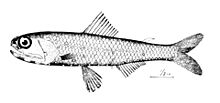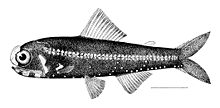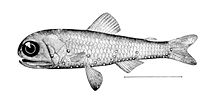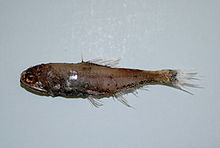Lanternfish
| Lanternfish | ||||||||||||
|---|---|---|---|---|---|---|---|---|---|---|---|---|

Slender- tailed lanternfish ( Myctophum punctatum ) |
||||||||||||
| Systematics | ||||||||||||
|
||||||||||||
| Scientific name | ||||||||||||
| Myctophidae | ||||||||||||
| Gill , 1893 |
The lantern fish (Myctophidae) are a species and individual rich family of small deep sea fish . Its sister family, the lantern beak (Neoscopelidae), is much poorer in species. Lanternfish live in all oceans. They got their name because of their luminous organs.
Lantern fish , together with the bristle mouths (Gonostomatidae) and the luminous fish (Phosichthyidae) make up 90% of the live mass of all deep-sea fish. Their total live mass is estimated at 550–660 million tons. Adult lantern fish make up 65% of all fish in the mesopelagial , when plankton is caught , the larvae of the lantern fish make up 50% of all fish larvae.
Lanternfish are fished commercially in South Africa, sub-Antarctic waters and the Gulf of Oman .
Appearance
Lanternfish have a small, slender body covered by small cycloid scales, a relatively large, round head, and a large mouth.
The animals have a single high dorsal fin and an adipose fin, the caudal fin is forked. The pectoral fins usually have eight rays. They can be large or small or degenerate, in some species they are completely absent.
Most lanternfish have a swim bladder . In some species it is regressed or filled with lipids during growth . The sideline is continuous.
All species, with the exception of Taaningichthys paurolychnus , have luminous organs emitting blue, green or yellow light in rows along the body and on the head. In the genus Diaphus z. B. There are headlight-like light organs near the eyes. Some species also have luminous organs on the underside of the fins. Sometimes the sexes also differ in the arrangement of the light organs. It is assumed that the luminous organs play a role in attracting partners and in keeping the swarm together.
ecology
Lanternfish make a vertical migration . During the day, most species stay in the dark bathypelagic zone at depths of 300 to 1200 meters. At sunset, the animals begin to rise to 10 to 100 meters. They follow the migration of the zooplankton on which they feed. At daybreak they swim back into the depths. The different species are at different depths. There can also be different vertical migration depending on age, gender, season or the latitude of the habitat.
Most of the species stay close to the coast and can be found above the continental slopes.
The shoals of lantern fish can be seen on echo sounder images and used to be a source of confusion among oceanographers who thought they were the seabed.
Lanternfish are an important source of food for squids , other deep-sea fish , large pelagic fish such as tuna and sharks , sea birds, penguins , whales and dolphins .
Reproduction
Lanternfish spawn pelagic in open water. The small eggs (0.70-0.90 millimeters in diameter) are held in suspension by a droplet of oil. Eggs and the two millimeter larvae float with the current. Lantern fish larvae live in shallower water than the adult animals.
Smaller species like Diogenichthys laternatus double their population within 15 months. Larger species need up to five years for this. Benthosema glaciale , a larger species, does not reach sexual maturity until 2-3 years and can live up to eight years.
Systematics
There are five subfamilies, 34 genera and about 250 species:
In the species of the subfamily Myctophinae, the luminous organs on the caudal peduncle are predominantly dimorphic . They have firmer bodies, a rounded, smooth head profile, shorter jaws, large eyes and mostly live in not as deep water layers as the species of the other subfamily. In the species of the other subfamilies, the luminous organs on the tail stalk are predominantly monomorphic. They usually live deeper than the species of the subfamily Myctophinae, have longer jaws and slacker bodies.
- Subfamily Diaphinae, 1972
- Genus Diaphus
- Diaphus adenomus Gilbert, 1905
- Diaphus aliciae Fowler, 1934
- Diaphus anderseni Tåning, 1932
- Diaphus antonbruuni Nafpaktitis, 1978
- Diaphus arabicus Nafpaktitis, 1978
- Diaphus basileusi Becker & Prut'ko, 1984
- Diaphus bertelseni Nafpaktitis, 1966
- Diaphus brachycephalus Tåning, 1928
- Diaphus burtoni Fowler, 1934
- Diaphus chrysorhynchus Gilbert & Cramer, 1897
- Diaphus coeruleus Klunzinger, 1871
- Diaphus confusus Becker, 1992
- Diaphus dahlgreni Fowler, 1934
- Diaphus danae Tåning, 1932
- Diaphus dehaveni Fowler, 1934
- Diaphus diadematus Tåning, 1932
- Diaphus diademophilus Nafpaktitis, 1978
- Diaphus drachmanni Tåning, 1932
- Diaphus dumerilii Bleeker, 1856
- Diaphus effulgens Goode & Bean, 1896
- Diaphus ehrhorni Fowler, 1934
- Diaphus faustinoi Fowler, 1934
- Diaphus fragilis Tåning, 1928
- Diaphus fulgens brewer, 1904
- Diaphus garmani Gilbert, 1906
- Diaphus gigas Gilbert, 1913
- Diaphus handi Fowler, 1934
- Diaphus holti Tåning, 1918
- Diaphus hudsoni Zurbrigg & Scott, 1976
- Diaphus impostor Nafpaktitis, Robertson & Paxton, 1995
- Diaphus jenseni Tåning, 1932
- Diaphus kapalae Nafpaktitis, Robertson & Paxton, 1995
- Diaphus habeni Nafpaktitis, 1978
- Diaphus kora Nafpaktitis, Robertson & Paxton, 1995
- Diaphus kuroshio Kawaguchi & Nafpaktitis, 1978
- Diaphus lobatus Nafpaktitis, 1978
- Diaphus longleyi Fowler, 1934
- Diaphus lucidus Goode & Bean, 1896
- Diaphus lucifrons Fowler, 1934
- Diaphus luetkeni brewer, 1904
- Diaphus malayanus Weber, 1913
- Diaphus mascarensis Becker, 1990
- Diaphus meadi Nafpaktitis, 1978
- Diaphus megalops Nafpaktitis, 1978
- Point-head lanternfish ( Diaphus metopoclampus ) Cocco, 1829
- Diaphus minax Nafpaktitis, 1968
- Diaphus mollis Tåning, 1928
- Diaphus nielseni Nafpaktitis, 1978
- Diaphus ostenfeldi Tåning, 1932
- Diaphus pacificus Parr, 1931
- Diaphus pallidus Gjøsaeter, 1989
- Diaphus parini Becker, 1992
- Diaphus parri Tåning, 1932
- Diaphus perspicillatus Ogilby, 1898
- Diaphus phillipsi Fowler, 1934
- Diaphus problematicus Parr, 1928
- Diaphus rafinesquii Cocco, 1838
- Diaphus regani Tåning, 1932
- Diaphus richardsoni Tåning, 1932
- Diaphus roei Nafpaktitis, 1974
- Diaphus sagamiensis Gilbert, 1913
- Diaphus schmidti Tåning, 1932
- Diaphus signatus Gilbert, 1908
- Diaphus similis Wisner, 1974
- Diaphus splendidus Brauer, 1904
- Diaphus suborbitalis Weber, 1913
- Diaphus subtilis Nafpaktitis, 1968
- Diaphus taaningi Norman, 1930
- Diaphus termophilus Tåning, 1928
- Diaphus theta Eigenmann & Eigenmann, 1890
- Diaphus thiollierei Fowler, 1934
- Diaphus trachops Wisner, 1974
- Diaphus umbroculus Fowler, 1934
- Diaphus vanhoeffeni brewer, 1906
- Diaphus watasei Jordan & Starks, 1904
- Diaphus whitleyi Fowler, 1934
- Diaphus wisneri Nafpaktitis, Robertson & Paxton, 1995
- Genus Idiolychnus
- Idiolychnus urolampus Gilbert & Cramer, 1897
- Genus Lobianchia
- Lobianchia dofleini Zugmayer, 1911
- Lobianchia gemellarii Cocco, 1838
- Genus Diaphus
- Subfamily Gymnoscopelinae Paxton, 1972
- Genus Gymnoscopelus
- Gymnoscopelus bolini Andriashev, 1962
- Gymnoscopelus braueri Lönnberg, 1905
- Gymnoscopelus fraseri Fraser-Brunner, 1931
- Gymnoscopelus hintonoides Hulley, 1981
- Gymnoscopelus microlampas Hulley, 1981
- Gymnoscopelus nicholsi Gilbert, 1911
- Gymnoscopelus opisthopterus Fraser-Brunner, 1949
- Gymnoscopelus piabilis Whitley, 1931
- Genus Hintonia
- Hintonia candens Fraser-Brunner, 1949
- Genus Lampanyctodes
- Lampanyctodes hectoris Günther, 1876
- Genus Lampichthys
- Lampichthys procerus brewer, 1904
- Genus Notoscopelus
 Krøyer's lantern fish ( Notoscopelus kroyeri )
Krøyer's lantern fish ( Notoscopelus kroyeri )- Notoscopelus bolini Nafpaktitis, 1975
- Notoscopelus caudispinosus Johnson, 1863
- Notoscopelus elongatus Costa, 1844
- Notoscopelus japonicus Tanaka, 1908
- Krøyer's Lantern Fish ( Notoscopelus kroyeri ) Malm, 1861
- Notoscopelus resplendens Richardson, 1845
- Genus Scopelopsis
- Scopelopsis multipunctatus Brauer, 1906
- Genus Gymnoscopelus
- Subfamily Notolychninae Paxton, 1972
- Genus Notolychnus
- Notolychnus valdiviae brewer, 1904
- Genus Notolychnus
- Subfamily Lampanyctinae Paxton, 1972
- Genus Bolinichthys
- Bolinichthys distofax Johnson, 1975
- Bolinichthys indicus Nafpaktitis & Nafpaktitis, 1969
- Bolinichthys longipes brewer , 1906
- Bolinichthys nikolayi Becker, 1978
- Bolinichthys photothorax Parr, 1928
- Bolinichthys pyrsobolus Alcock, 1890
- Bolinichthys supralateralis Parr, 1928
- Genus Ceratoscopelus
- Ceratoscopelus maderensis Lowe, 1839
- Ceratoscopelus townsendi Eigenmann & Eigenmann, 1889
- Ceratoscopelus warmingii Lütken, 1892
- Genus Lampadena
- Lampadena anomala Parr, 1928
- Lampadena chavesi Collett, 1905
- Lampadena dea Fraser-Brunner, 1949
- Lampadena luminosa Garman, 1899
- Lampadena notialis Nafpaktitis & Paxton, 1968
- Lampadena pontifex Krefft, 1970
- Lampadena speculigera Goode & Bean, 1896
- Lampadena urophaos Paxton, 1963
- Lampadena yaquinae Coleman & Nafpaktitis, 1972
- Genus Lampanyctus , Syn . : Nannobrachium
- Lampanyctus acanthurus Wisner, 1974
- Lampanyctus achirus (Andriashev, 1962)
- Lampanyctus alatus Goode & Bean, 1896
- Lampanyctus atrum (Tåning, 1928)
- Lampanyctus australis Tåning, 1932
- Lampanyctus bristori (Zahuranec, 2000)
- Lampanyctus crocodilus (Risso, 1810)
- Lampanyctus crypticum (Zahuranec, 2000)
- Lampanyctus cuprarium (Tåning, 1928)
- Lampanyctus fernae (Wisner, 1971)
- Lampanyctus festivus Tåning, 1928
- Lampanyctus gibbsi (Zahuranec, 2000)
- Lampanyctus hawaiiensis (Zahuranec, 2000)
- Lampanyctus hubbsi Wisner, 1963
- Lampanyctus idostigma (Parr, 1931)
- Lampanyctus indicum (Zahuranec, 2000)
- Lampanyctus intricarius Tåning, 1928
- Lampanyctus isaacsi (Wisner, 1974)
- Lampanyctus iselinoides Bussing, 1965
- Lampanyctus jordani Gilbert, 1913
- Lampanyctus lepidolychnus Becker, 1967
- Lampanyctus lineatum (Tåning, 1928)
- Lampanyctus macdonaldi (Goode & Bean, 1896)
- Lampanyctus macropterus (Brauer, 1904)
- Lampanyctus nigrum (Günther, 1887)
- Lampanyctus nobilis Tåning, 1928
- Lampanyctus omostigma Gilbert, 1908
- Lampanyctus parvicauda Parr, 1931
- Lampanyctus photonotus Parr, 1928
- Lampanyctus phyllisae (Zahuranec, 2000)
- Lampanyctus pusillus (Johnson, 1890)
- Lampanyctus regale (Gilbert, 1892)
- Lampanyctus ritteri (Gilbert, 1915)
- Lampanyctus simulator Wisner, 1971
- Lampanyctus steinbecki Bolin, 1939
- Lampanyctus tenuiformis (Brauer, 1906)
- Lampanyctus turneri (Fowler, 1934)
- Lampanyctus vadulus Hulley, 1981
- Lampanyctus wisneri (Zahuranec, 2000)
- Genus Lepidophanes
- Lepidophanes gaussi brewer, 1906
- Lepidophanes guentheri Goode & Bean, 1896
- Genus Parvilux
- Parvilux boschmai Hubbs & Wisner, 1964
- Parvilux ingens Hubbs & Wisner, 1964
- Genus Stenobrachius
- Stenobrachius leucopsarus Eigenmann & Eigenmann, 1890
- Stenobrachius nannochir Gilbert, 1890
- Genus Taaningichthys
- Taaningichthys bathyphilus Tåning, 1928
- Taaningichthys minimus Tåning, 1928
- Taaningichthys paurolychnus Davy, 1972
- Genus Triphoturus
- Triphoturus mexicanus Gilbert, 1890
- Triphoturus nigrescens brewer, 1904
- Triphoturus oculeum Garman, 1899
- Genus Bolinichthys
- Subfamily Myctophinae
- Genus Benthosema
 Ice lantern fish ( Benthosema glaciale )
Ice lantern fish ( Benthosema glaciale )- Benthosema fibulatum Gilbert & Cramer, 1897
- Ice lantern fish ( Benthosema glaciale ) Reinhardt, 1837
- Benthosema panamense Tåning, 1932
- Benthosema pterotum Alcock, 1890
- Benthosema suborbitale Gilbert, 1913
- Genus Centrobranchus
- Centrobranchus andreae Lütken, 1892
- Centrobranchus brevirostris Becker, 1964
- Centrobranchus choerocephalus Fowler, 1904
- Centrobranchus nigroocellatus Günther, 1873
- Genus Ctenoscopelus
- Ctenoscopelus phengodes (Lütken, 1892)
- Genus Dasyscopelus
- Dasyscopelus asperum (Richardson, 1845)
- Dasyscopelus orientale (Gilbert, 1913)
- Dasyscopelus spinosum (Steindachner, 1867)
- Genus Diogenichthys
- Diogenichthys atlanticus Tåning, 1928
- Diogenichthys laternatus Garman, 1899
- Diogenichthys panurgus Bolin, 1946
- Electrona genus
- Electrona antarctica Günther, 1878
- Electrona carlsbergi Tåning, 1932
- Electrona paucirastra Bolin, 1962
- Electrona risso Cocco, 1829
- Electrona subaspera Günther, 1864
- Genus Gonichthys
- Gonichthys barnesi Whitley, 1943
- Gonichthys cocco Cocco, 1829
- Gonichthys tenuiculus Garman, 1899
- Gonichthys venetus Becker, 1964
- Genus Hygophum
- Hygophum atratum Garman, 1899
- Hygophum benoiti Cocco, 1838
- Hygophum bruuni Wisner, 1971
- Hygophum hanseni Tåning, 1932
- Hygophum hygomii Lütken, 1892
- Hygophum macrochir Günther, 1864
- Hygophum proximum Becker, 1965
- Hygophum reinhardtii Lütken, 1892
- Hygophum taaningi Becker, 1965
- Genus Krefftichthys
- Krefftichthys anderssoni Lönnberg, 1905
- Genus Loweina
- Loweina interrupta Tåning, 1928
- Loweina rara Lütken, 1892
- Loweina terminata Becker, 1964
- Genus Metelectrona
- Metelectrona ahlstromi Wisner, 1963
- Metelectrona herwigi Hulley, 1981
- Metelectrona ventralis Becker, 1963
- Genus Myctophum
- Myctophum affine Lütken, 1892
- Myctophum aurolaternatum Garman, 1899
- Myctophum brachygnathum Bleeker, 1856
- Myctophum fissunovi Becker & Borodulina, 1971
- Myctophum indicum Day, 1877
- Myctophum lunatum Becker & Borodulina, 1978
- Myctophum lychnobium Bolin, 1946
- Myctophum nitidulum Garman, 1899
- Myctophum obtusirostre Tåning, 1928
- Myctophum ovcharovi Tsarin, 1993
- Slender- tailed lanternfish ( Myctophum punctatum ) Rafinesque, 1810
- Myctophum selenops Tåning, 1928
- Genus Protomyctophum
- Protomyctophum andriashevi Becker, 1963
- Arctic lantern fish ( Protomyctophum arcticum ) Lütken, 1892
- Protomyctophum beckeri Wisner, 1971
- Protomyctophum bolini Fraser-Brunner, 1949
- Protomyctophum chilense Wisner, 1971
- Protomyctophum choriodon Hulley, 1981
- Protomyctophum crockeri Bolin, 1939
- Protomyctophum gemmatum Hulley, 1981
- Protomyctophum luciferum Hulley, 1981
- Protomyctophum normani Tåning, 1932
- Protomyctophum parallelum Lönnberg, 1905
- Protomyctophum subparallelum Tåning, 1932
- Protomyctophum tenisoni Norman, 1930
- Protomyctophum thompsoni Chapman, 1944
- Genus Symbolophorus
- Symbolophorus barnardi Tåning, 1932
- Symbolophorus boops Richardson, 1845
- Symbolophorus californiensis Eigenmann & Eigenmann, 1889
- Symbolophorus evermanni Gilbert, 1905
- Symbolophorus kreffti Hulley, 1981
- Symbolophorus reversus Gago & Ricord, 2005
- Symbolophorus rufinus Tåning, 1928
- Symbolophorus veranyi Moreau, 1888
- Genus Tarletonbeania
- Tarletonbeania crenularis Jordan & Gilbert, 1880
- Tarletonbeania taylori Mead, 1953
- Genus Benthosema
literature
- John SS Denton: Seven-locus molecular phylogeny of Myctophiformes (Teleostei; Scopelomorpha) highlights the utility of the order for studies of deep-sea evolution. Molecular Phylogenetics and Evolution, February 2014, doi: 10.1016 / j.ympev.2014.02.009 .
- Kurt Fiedler: Textbook of Special Zoology, Volume II, Part 2: Fish , Gustav Fischer Verlag, Jena, 1991, ISBN 3-334-00339-6 .
- Joseph S. Nelson : Fishes of the World , John Wiley & Sons, 2006, ISBN 0-471-25031-7 .
- Motoomi Yamaguchi: Phylogenetic analyzes of myctophid fishes using morphological characters. Japanese Journal of Ichthyology. Vol. 47; No. 2; Pp. 87-107; (2000), doi: 10.11369 / jji1950.47.87 .
Individual evidence
- ↑ a b Rene P. Martin, Emily E.Olson, Matthew G.Girard, Leo Smith, Matthew P.Davis: Light in the Darkness: New Perspective on lanternfish Relationships and Classification Using Genomic and Morphological Data. Molecular Phylogenetics and Evolution, January 2018, doi: 10.1016 / j.ympev.2017.12.029 .
- ^ Denton (2014), pp. 7–8.
Web links
- Lanternfish on Fishbase.org (English)
- Stiassny, Melanie LJ 1997. Myctophidae. Lanternfishes. Version 01 January 1997 (under construction). in The Tree of Life Web Project
































